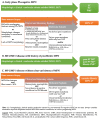The Classification of Myeloproliferative Neoplasms: Rationale, Historical Background and Future Perspectives with Focus on Unclassifiable Cases
- PMID: 34830822
- PMCID: PMC8616346
- DOI: 10.3390/cancers13225666
The Classification of Myeloproliferative Neoplasms: Rationale, Historical Background and Future Perspectives with Focus on Unclassifiable Cases
Abstract
Myeloproliferative neoplasms (MPNs) are a heterogeneous group of clonal hematopoietic stem cell disorders, characterized by increased proliferation of one or more myeloid lineages in the bone marrow. The classification and diagnostic criteria of MPNs have undergone relevant changes over the years, reflecting the increased awareness on these conditions and a better understanding of their biological and clinical-pathological features. The current World Health Organization (WHO) Classification acknowledges four main sub-groups of MPNs: (i) Chronic Myeloid Leukemia; (ii) classical Philadelphia-negative MPNs (Polycythemia Vera; Essential Thrombocythemia; Primary Myelofibrosis); (iii) non-classical Philadelphia-negative MPNs (Chronic Neutrophilic Leukemia; Chronic Eosinophilic Leukemia); and (iv) MPNs, unclassifiable (MPN-U). The latter are currently defined as MPNs with clinical-pathological findings not fulfilling the diagnostic criteria for any other entity. The MPN-U spectrum traditionally encompasses early phase MPNs, terminal (i.e., advanced fibrotic) MPNs, and cases associated with inflammatory or neoplastic disorders that obscure the clinical-histological picture. Several lines of evidence and clinical practice suggest the existence of additional myeloid neoplasms that may expand the spectrum of MPN-U. To gain insight into such disorders, this review addresses the history of MPN classification, the evolution of their diagnostic criteria and the complex clinical-pathological and biological features of MPN-U.
Keywords: MPN-U; Myeloproliferative neoplasms; WHO Classification; myeloid disorders.
Conflict of interest statement
The Authors declare no conflict of interest.
Figures





Similar articles
-
The 2016 WHO classification and diagnostic criteria for myeloproliferative neoplasms: document summary and in-depth discussion.Blood Cancer J. 2018 Feb 9;8(2):15. doi: 10.1038/s41408-018-0054-y. Blood Cancer J. 2018. PMID: 29426921 Free PMC article. Review.
-
Classical Philadelphia-negative myeloproliferative neoplasms (MPNs): A continuum of different disease entities.Int Rev Cell Mol Biol. 2021;365:1-69. doi: 10.1016/bs.ircmb.2021.09.001. Epub 2021 Sep 28. Int Rev Cell Mol Biol. 2021. PMID: 34756241 Review.
-
Myeloproliferative Neoplasms.2023 Aug 8. In: StatPearls [Internet]. Treasure Island (FL): StatPearls Publishing; 2025 Jan–. 2023 Aug 8. In: StatPearls [Internet]. Treasure Island (FL): StatPearls Publishing; 2025 Jan–. PMID: 30285359 Free Books & Documents.
-
Myeloproliferative neoplasms working group consensus recommendations for diagnosis and management of primary myelofibrosis, polycythemia vera, and essential thrombocythemia.Indian J Med Paediatr Oncol. 2015 Jan-Mar;36(1):3-16. doi: 10.4103/0971-5851.151770. Indian J Med Paediatr Oncol. 2015. PMID: 25810569 Free PMC article.
-
Diagnostic Approach to Myeloproliferative Neoplasms and Myelodysplastic/Myeloproliferative Neoplasms.Adv Anat Pathol. 2025 Jul 1;32(4):284-298. doi: 10.1097/PAP.0000000000000493. Epub 2025 Apr 17. Adv Anat Pathol. 2025. PMID: 40243206 Review.
Cited by
-
Real-World Impact of Deep Targeted Sequencing on Erythrocytosis and Thrombocytosis Diagnosis: A Reference Centre Experience.Cancers (Basel). 2024 Sep 14;16(18):3149. doi: 10.3390/cancers16183149. Cancers (Basel). 2024. PMID: 39335122 Free PMC article.
-
Toxicity of targeted anticancer treatments on the liver in myeloproliferative neoplasms.World J Hepatol. 2023 Sep 27;15(9):1021-1032. doi: 10.4254/wjh.v15.i9.1021. World J Hepatol. 2023. PMID: 37900211 Free PMC article. Review.
-
Bleeding Complications in JAK2-Variant Essential Thrombocythemia: A Revisit in 2025.EJHaem. 2025 Jul 4;6(4):e70088. doi: 10.1002/jha2.70088. eCollection 2025 Aug. EJHaem. 2025. PMID: 40625825 Free PMC article. Review.
-
Myelodysplastic syndromes mortality in Spain: a comprehensive age-period-cohort and joinpoint analysis.Clin Transl Oncol. 2024 Apr;26(4):917-923. doi: 10.1007/s12094-023-03321-3. Epub 2023 Sep 28. Clin Transl Oncol. 2024. PMID: 37768539
-
Classification of Myelodysplastic, Myeloproliferative, and Myelodysplastic/Myeloproliferative Neoplasms: The Past, Present, and Future.Am J Hematol. 2025 Jun;100 Suppl 4(Suppl 4):5-15. doi: 10.1002/ajh.27656. Epub 2025 Mar 8. Am J Hematol. 2025. PMID: 40056065 Free PMC article. Review.
References
-
- Swerdlow S.H., Campo E., Harris N.L., Jaffe E.S., Pileri S.A., Stein H., Thiele J. WHO Classification of Tumours of Haematopoietic and Lymphoid Tissues. IARC Press; Lyon, France: 2017.
-
- Szuber N., Mudireddy M., Nicolosi M., Penna D., Vallapureddy R.R., Lasho T.L., Finke C., Begna K.H., Elliott M.A., Hook C.C., et al. 3023 Mayo Clinic Patients with Myeloproliferative Neoplasms: Risk-Stratified Comparison of Survival and Outcomes Data Among Disease Subgroups. Mayo Clin. Proc. 2019;94:599–610. doi: 10.1016/j.mayocp.2018.08.022. - DOI - PubMed

